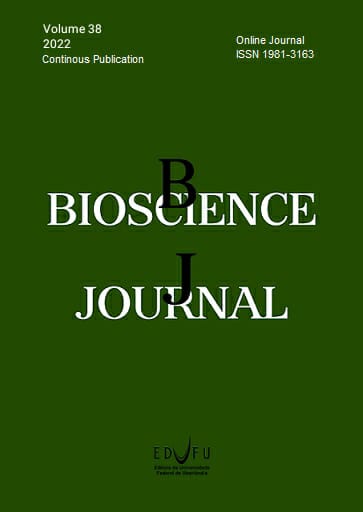How does the condition of the pasture in late winter influence the plant and animal responses in the subsequent seasons?
DOI:
https://doi.org/10.14393/BJ-v38n0a2022-54042Keywords:
Brachiaria brizantha syn. Urochloa brizantha, Hand-plucked sample, Morphological composition, Urochloa brizantha.Abstract
This study aimed to test the hypotheses: (i) the deferred pasture with lower height in late winter has greater herbage accumulation rate (HAR) and better structure, which facilitates the animal selective grazing during the subsequent spring and summer; (ii) the mowed of high pasture in late winter improves the sward structure but decreases its HAR from the spring. Four pasture condition in late winter of Urochloa brizantha cv. Marandu were evaluated: low (24.1 cm and 2,420 kg.ha-1 of DM); low/mowed (25.2 cm and 2,198 kg.ha-1 of DM, mowed at 8.0 cm); high (49.0 cm and 3,837 kg.ha-1 of DM); and high/mowed (50.0 cm and 4,211 kg.ha-1 DM, mowed at 8.0 cm). The highest live leaf blade percentage (LLBP) and the lowest dead stem percentage (DSP) occurred in the mowed pastures. The live stem (LSP) and dead leaf blade percentages of the grazing simulation sample were higher in the high pasture. This same pattern of response occurred for apparent selectivity indices (ASI) of the live leaf blade and live stem. The ASI of the dead leaf blade was greater in the high pasture, intermediate in the mowed pastures, and lower in the low pasture. The ASI of the dead stem was lower in the low pasture. The HAR was higher in low pasture. Our results support the first hypothesis. The mowing of high pasture in late winter improves the sward structure and the animal selective grazing but does not decrease the HAR during spring and summer.
References
AFONSO, L.E.F., et al. O capim-marandu baixo no início do diferimento melhora a morfologia do pasto e aumenta o desempenho dos ovinos no inverno. Arquivo Brasileiro de Medicina Veterinária e Zootecnia. 2018, 70(4), 1249-1256. https://doi.org/10.1590/1678-4162-10130
ALVARES, C.A., et al. Köppen’s climate classification map for Brazil. Meteorologische Zeitschrift. 2013, 22(6), 711–728. https://doi.org/10.1127/0941-2948/2013/0507
ALVES, LC., et al. Morphogenesis of age groups of Marandu palisade grass tillers deferred and fertilised with nitrogen. Semina. Ciências Agrárias. 2019, 40(6), 2683-2692. https://doi.org/10.5433/1679-0359.2019v40n6p268
CARVALHO, A.N., et al. Como a idade do perfilho e a adubação nitrogenada modificam as características estruturais do capim-marandu diferido?. Ciência Animal Brasileira. 2019, 20, e44460. https://doi.org/10.1590/1809-6891v20e-44460
CARVALHO, B.H.R., et al. Height and mowing of pasture at the end of winter modulate the tillering of Marandu palisadegrass in spring. Tropical Grasslands - Forrajes Tropicales. 2021, 9(1), 13-22. https://doi.org/10.17138/tgft(9)13-22
COSTA, L.K.P., et al. Reduction of sward height in the fall/winter as strategy to optimize tillering in Urochloa brizantha syn. Brachiaria brizantha. Archivos de Zootecnia. 2016, 65(252), 499-506. https://doi.org/10.21071/az.v65i252.1917
PAIVA, A.J., et al. Morphogenesis on age categories of tillers in marandu palisadegrass. Scientia Agricola. 2011, 68(6), 626-631. https://doi.org/10.1590/S0103-90162011000600003
ROCHA, G.O., et al. Structure of piatã palisadegrass deferred for two periods and fertilised with nitrogen. Semina. Ciencias Agrarias. 2020, 41(3), 995-1006. https://doi.org/10.5433/1679-0359.2020v41n3p995
SANTANA, S.S., et al. Initial height of pasture deferred and utilized in winter and tillering dynamics of signal grass during the following spring. Acta Scientiarum. Animal Sciences. 2014, 36(1), 17-23. https://doi.org/10.4025/actascianimsci.v36i1.20463
SANTOS, A.D., et al. Pasture structure and production of supplemented cattle in deferred pastures with signal grass. Ciência Animal Brasileira. 2020, 21, 1e-43578. https://doi.org/10.1590/1809-6891v21e-43578
SANTOS, M.E.R., FONSECA, D.M. and SOUZA, D.O.C. Seletividade aparente de bovinos em pastos de capim-braquiária sob períodos de diferimento. Arquivo Brasileiro de Medicina Veterinária e Zootecnia. 2016, 68(6), 1655-1663. https://doi.org/10.1590/1678-4162-8725
SANTOS, M.E.R., et al. Apparent selectivity of sheep in deferred marandu palisadegrass pastures with variable initial heights. Arquivo Brasileiro de Medicina Veterinária e Zootecnia. 2019, 71(5), 1727-1734. https://doi.org/10.1590/1678-4162-10750
SBRISSIA, A.F. and DA SILVA, S.C. Compensação tamanho/densidade populacional de perfilhos em pastos de capim-marandu. Revista Brasileira de Zootecnia. 2008, 37(1), 35-47. https://doi.org/10.1590/S1516-35982008000100005
SBRISSIA, A.F., et al. Unravelling the relationship between a seasonal environment and the dynamics of forage growth in grazed swards. Journal of Agronomy and Crop Science. 2020, 206(5), 630-639. https://doi.org/10.1111/jac.12402
SILVA, C.S., et al. Steer performance on deferred pastures of Brachiaria brizantha and Brachiaria decumbens. Ciência Rural. 2016, 46(11), 1998-2004. https://doi.org/10.1590/0103-8478cr20151525
SOUSA, D.O.C., et al. Sheep production during the rainy season in marandu palisadegrass swards previously utilized under deferred grazing. Arquivo Brasileiro de Medicina Veterinária e Zootecnia. 2018, 70(2), 1-8. https://doi.org/10.1590/1678-4162-9414
SOUZA, D.O.C., et al. A roçada do capim-marandu alto no fim do inverno melhora a estrutura do pasto no início do verão. Enciclopédia Biosfera. 2015, 11(21), 12-22.
THORNTHWAITE, C.W. and MATHER, J.R. The water balance. 1st Ed. Centerton, NJ: Drexel Institute of Technology - Laboratory of Climatology, 1955.
YASUOKA, J.I., et al. The exclosure cage technique revisited: Pasture responses under continuous stocking and their relationship with estimates of forage accumulation in grazing experiments. Crop Science. 2021, 61(2), 1488-1499. https://doi.org/10.1002/csc2.20447
Downloads
Published
Issue
Section
License
Copyright (c) 2022 Manoel Eduardo Rozalino Santos, Fernanda Rosalinski Moraes, Gabriel de Oliveira Rocha, Davi Moraes de Oliveira, Flávia de Oliveira Scarpino van Cleef, Bruno Humberto Rezende Carvalho

This work is licensed under a Creative Commons Attribution 4.0 International License.





